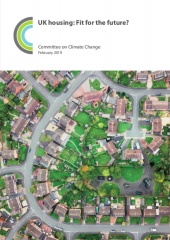UK housing: Fit for the future?
Document types:
Document weight:
Document geography:
Geographical spread:
Key messages
UK homes are not fit for the future. Greenhouse gas emission reductions from UK housing have stalled, and efforts to adapt the housing stock for higher temperatures, flooding and water scarcity are falling far behind the increase in risk from the changing climate. The quality, design and use of homes across the UK must be improved now to address the challenges of climate change. Doing so will also improve health, wellbeing and comfort, including for vulnerable groups such as the elderly and those living with chronic illnesses. This report identifies five priorities for government action:
1. Performance and compliance. The way new homes are built and existing homes retrofitted often falls short of design standards. This is unacceptable. In the long run, consumers pay a heavy price for poor-quality build and retrofit. Greater levels of inspection and stricter enforcement of building standards are required, alongside stiffer penalties for non-compliance. The 'as-built' performance of homes, for example how thermally efficient they are, must also be better monitored. Closing the energy use performance gap in new homes (the difference between how they are designed and how they actually perform) could save between £70 and £260 in energy bills per household per year.
2. Skills gap. The chopping and changing of UK Government policy has inhibited skills development in housing design, construction and in the installation of new measures. Key steps for the UK in reducing emissions, like the wider deployment of heat pumps, require new skills. The UK Government should use initiatives under the Construction Sector Deal to tackle this low-carbon skills gap. New support to train designers, builders and installers is needed for low-carbon heating, energy and water efficiency, ventilation and thermal comfort, and property-level flood resilience.
3. Retrofitting existing homes. The 29 million existing homes across the UK must be made low- carbon, low-energy and resilient to a changing climate. This is a UK infrastructure priority and should be supported as such by HM Treasury. Homes should use low-carbon sources of heating such as heat pumps and heat networks. The uptake of energy efficiency measures such as loft and wall insulation must be increased. At the same time, upgrades or repairs to homes should include increasing the uptake of: passive cooling measures (shading and ventilation); measures to reduce indoor moisture; improved air quality and water efficiency; and, in homes at risk of flooding, the installation of property-level flood protection.
4. Building new homes. There are plans for 1.5 million new UK homes by 2022. These new homes must be built to be low-carbon, energy and water efficient and climate resilient. The costs of building to a specification that achieves the aims set out in this report are not prohibitive, and getting design right from the outset is vastly cheaper than forcing retrofit later. From 2025 at the latest, no new homes should be connected to the gas grid. They should instead be heated through low carbon sources, have ultra-high levels of energy efficiency alongside appropriate ventilation and, where possible, be timber-framed. A statutory requirement for reducing overheating risks in new builds is needed, alongside more ambitious water efficiency standards, property-level flood protection in flood risk areas, and increasing requirements for greenspace and sustainable transport in planning and guidance.
5. Finance and funding. There are urgent funding needs which must be addressed now with the support of HM Treasury: low-carbon heating (currently only funded up to 2021), and resources for local authorities, in particular building control. The UK Government must implement the Green Finance Taskforce recommendations around green mortgages, green loans and fiscal incentives to help finance upfront costs, as well as improving consumer access to data and advice. It should widen the scope of these measures to include resilience. Householders can also make a big difference with small changes. Even before these actions can be delivered by Government, many householders can make changes immediately to lower their utility bills and improve their homes, for example setting boilers to the correct temperature, installing shading, and increasing insulation.
See Section 3.4 for recommendations on transport, and on active travel in particular.

